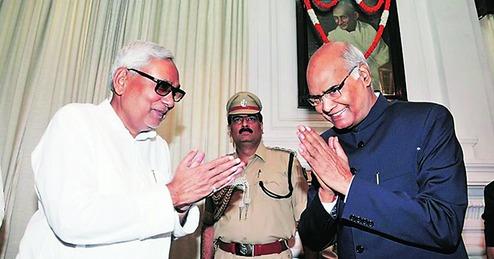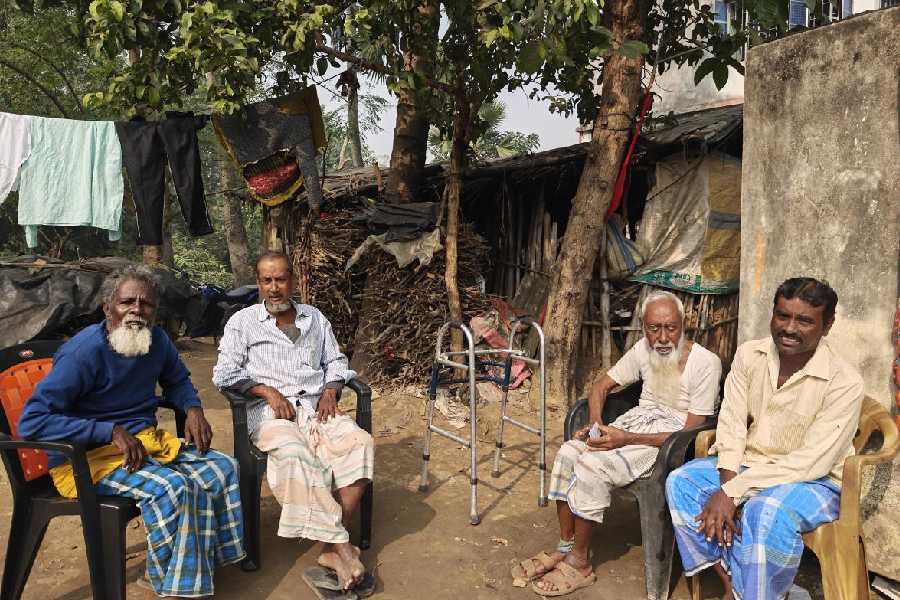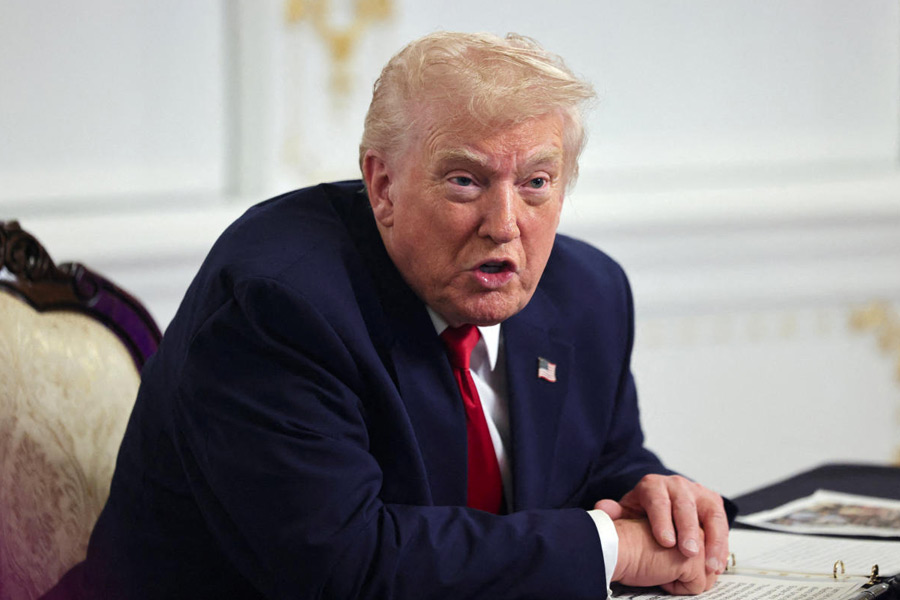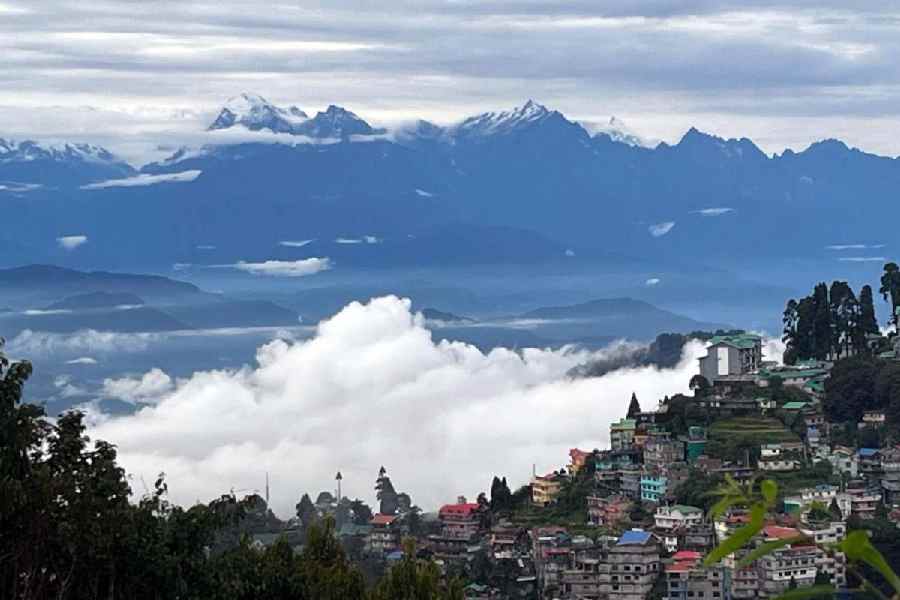
Exactly a week ago, the Bihar chief minister, Nitish Kumar, took a swipe at all the hype and hoopla surrounding the third edition of International Yoga Day. Speaking to the media on the sidelines of his weekly "Lok Samvad" programme, Nitish said, "Promoting yoga is a good thing to do, but trying to gain votes through yoga is not a good thing."
Slamming the "publicity stunt" that the yoga day was set to become, Nitish added, "Yoga isn't something which is done on a particular day. I practise yoga everyday but I do not speak about it."
The very next day, the Bihar chief minister gave ample proof of his skills at yoga, albeit in a way very different from that of the assortment of Bharatiya Janata Party leaders who contorted their bodies before cameras across the country on June 21.
As any practitioner knows, the ultimate goal of yoga is to still the mind but the primary requirement for doing the physical asanas (poses) is a supple spine. Over the last one week, Nitish Kumar has shown us - once again - that when it comes to politics, he has an ideological backbone that is very flexible indeed.
Nitish's latest display of ideological flexibility has come in response to Narendra Modi's decision to field the little-known Bihar governor, Ram Nath Kovind, for the post of the next president of India. The choice of Kovind - a Rashtriya Swayamsevak Sangh fellow traveller and late entrant to the Bharatiya Janata Party who also happens to belong to the Dalit community - took even ruling party members by surprise.
Everyone was quick to declare the choice as Modi's "master stroke". But what rendered the stroke masterly was, arguably, not the choice itself but Nitish Kumar's enthusiastic endorsement of it. Nitish was the first Opposition leader to praise the selection of Kovind, who had been appointed Bihar governor less than two years ago in August 2015. In this short space of time, Kovind had endeared himself to Nitish, it seems.
The alacrity with which Nitish backed Kovind and then got the Janata Dal (United) to officially endorse him - a day ahead of the meeting of 17 Opposition parties to decide on their choice for the post - made many wonder whether Nitish had known of Kovind's choice well in advance. Some even suggested that it was Nitish who proposed Kovind's name to Modi.
We will never know if there is any truth in this speculation. But what we do know - and have seen for ourselves - is that the Bihar chief minister is adept at political gymnastics and has just executed yet another somersault.
Nitish Kumar, his supporters might argue, is not the only non-BJP chief minister to endorse Kovind. Naveen Patnaik and N. Chandrababu Naidu, K. Chandrashekhar Rao and E.K. Palaniswami have all trooped in to back the government's choice. Even the Bahujan Samaj Party chief, Mayavati, who expressed reservations about Kovind's RSS leanings, indicated that she may have to back a Dalit candidate unless the Opposition also puts up a Dalit.
But Nitish Kumar stands out because he has always tried to exude a different aura - claiming to be a man of principle for whom ideology is not an empty concept. Naveen Patnaik and Chandrababu Naidu, on the other hand, are happy to be regarded as "pragmatists" - solely concerned with running their respective states, and seeking a transactional relationship with the Centre.
Nitish, in contrast, has sought to maintain - and partially succeeded in maintaining - a certain halo in spite of changing political partners at will. In 1994, he broke with his long-time associate Lalu Prasad to form the Samata Party. After being trounced by Lalu in 1995, the Samata Party aligned with the BJP in 1996. It merged with other Janata factions to emerge as the Janata Dal (United) in 2003, but the alliance with the BJP endured - the two jointly running the Bihar government from 2005 to 2013.
In 2013, Nitish Kumar suddenly turned allergic to the BJP - or rather to Narendra Modi. Nitish had always tried to keep a distance from Modi after the post-Godhra riots (although, typically, he refused to resign from the Atal Bihari Vajpayee cabinet when the riots took place).
But it was in 2013, when the BJP was set to project Narendra Modi as its prime ministerial candidate, that Nitish decided to regain his "secular" credentials. At a Janata Dal (U) meeting in Delhi in April 2013, Nitish warned that he would break his alliance with the BJP if the party went ahead with Modi. "Whether power remains or goes, we cannot compromise on ideology," he thundered. Two months later, he broke the alliance and won a trust vote after the BJP walked out and the Congress supported him.
Nitish's tirade against Modi didn't stop the BJP from sweeping Bihar in the 2014 general elections. Nitish resigned as chief minister owning "moral responsibility" for the defeat and anointed a "mahadalit", Jitan Ram Manjhi, as chief minister. When Manjhi refused to be a pliable proxy, Nitish managed to oust him and resume the post of chief minister. And in 2015, he famously joined hands with his bitter enemy Lalu, and the "grand alliance" swept to power - with Nitish once again becoming chief minister even though Lalu's Rashtriya Janata Dal won more seats than the JD(U).
But just as Nitish dropped Lalu only to befriend him again sensing better chances with a "secular" alliance, the Bihar chief minister now seems to have decided that it is time to make overtures to another old friend turned enemy, the BJP. And a key to this turnaround is overcoming his much-publicized allergy towards Narenda Modi and striking a new rapport with him.
Make no mistake. Nitish Kumar's support for Ram Nath Kovind is not just about backing an individual. As an old socialist, Nitish knows better than most that no individual can be placed above ideology, especially in the deeply divisive and fraught climate that has gripped India since 2014.
The irony is that Nitish was the first to make this point in public. More than four months ago, on a visit to Delhi to release P. Chidambaram's book, Nitish spoke eloquently about the crying need for "Opposition unity". Before making this public plea, he met Left leaders and stressed the need for a joint strategy for the presidential polls later in the year. He was also among the first leaders to talk to Sonia Gandhi, and his party colleague, Sharad Yadav, a key interlocutor with other parties in the search for a suitable presidential candidate.
Not since 1969, when Indira Gandhi pitted the "independent" V.V. Giri against the Congress's official candidate, N. Sanjeeva Reddy, as part of the larger battle within the Grand Old Party, has a presidential election been as ideologically significant as this one.
After three years of RSS-BJP dominance that has seen a concerted effort to transform the basic tenets of India's secular democracy and allow free rein to lynch mobs to attack Muslims, Dalits, "liberals" and "anti-nationals" both verbally and physically, the presidential election offered the first opportunity for the dispirited and lethargic Opposition to come together and offer something of a fight. The election may be a symbolic fight - but symbolism is often the precursor of more robust and substantive politics.
By breaking ranks with the Opposition at this crucial juncture, Nitish Kumar has not just signalled a new bonhomie with Modi but also let it be known that for all his "socialist" roots and "secular" pretensions, he has no qualms about a man with RSS leanings taking over as the supreme commander of India's armed forces. That is why long after Ram Nath Kovind is ensconced in Rashtrapati Bhavan, this presidential election will be remembered for highlighting Nitish Kumar's skills as a consummate contortionist.










